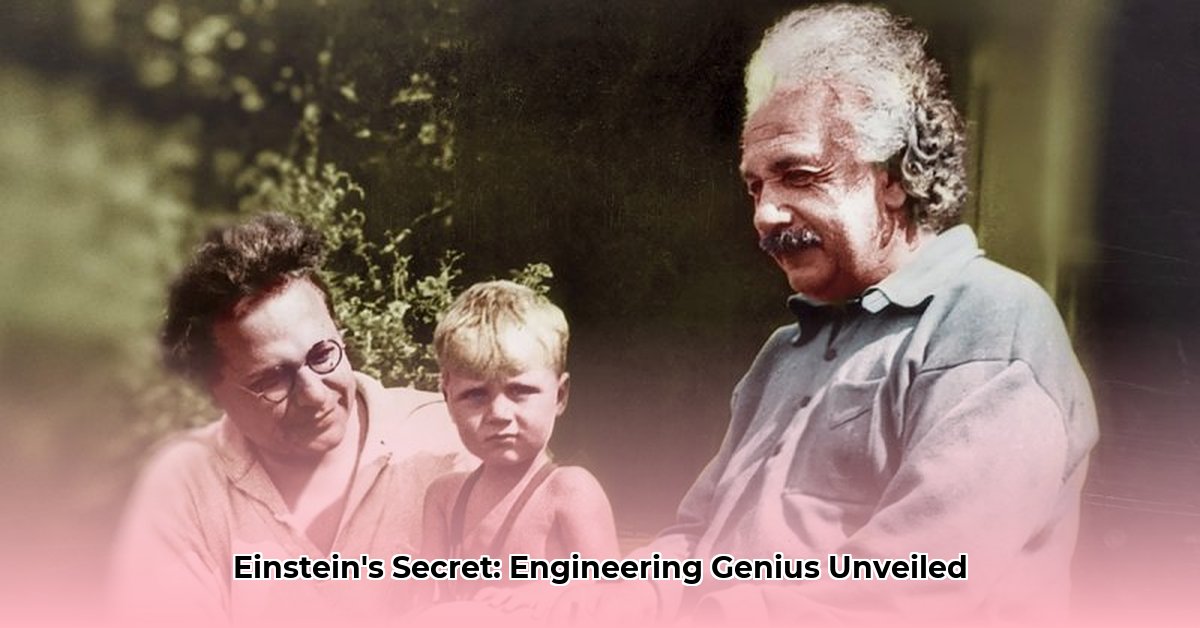Bernhard Caesar Einstein, grandson of the iconic Albert Einstein, may not be a household name, but his engineering contributions significantly impacted modern technology. This article unveils his story, focusing on his work in electronics and laser technology and their lasting impact on various industries and defense applications. For a deeper dive into his scientific achievements, see this resource.
Bernhard Caesar Einstein: An Engineering Legacy Forged in Innovation
While Albert Einstein revolutionized theoretical physics, Bernhard Einstein carved his own path as a practical engineer. He focused on tangible advancements in electronics and laser technology. His journey took him from the University of California, Berkeley, to the Swiss Federal Institute of Technology (ETH Zurich), blending American and European engineering approaches. This unique combination, coupled with his time in the Swiss Army, likely fostered a deep appreciation for robust and reliable systems, significantly shaping his later work.
- Bernhard Einstein focused on practical engineering, a departure from his grandfather’s theoretical pursuits.
- He improved electronics and laser technology, innovations with direct impacts on daily life and specialized applications.
- His education at ETH Zurich and his experience in the Swiss Army instilled a focus on reliable and durable system design.
Enhancing Electronics: Innovations in Electron Tubes and Semiconductor Devices
Bernhard held numerous patents, many focused on improving electron tubes, the foundation of early radios, televisions, and various industrial control systems. His innovations enhanced their efficiency, reliability, and durability, addressing critical limitations of the time. These weren’t minor adjustments; they dramatically increased the lifespan and performance of these devices, significantly influencing countless applications, and also laid groundwork for advancements in semiconductor technology which were rapidly evolving during his career.
Night Vision Advancements: Illuminating the Darkness
Bernhard also explored light amplification, a crucial field for night vision technology. His work at Litton Industries, a major defense contractor, suggests his involvement in enhancing the capabilities of night vision systems. These advancements likely improved the clarity, range, and overall reliability of night vision systems, with significant implications for military operations, search and rescue missions, and civilian safety applications.
Pioneering Laser Technology: Harnessing Light’s Potential
Bernhard’s work extended to laser technology, a field experiencing rapid growth and diversification during his career. Lasers have since revolutionized various industries, from medical procedures and advanced manufacturing to telecommunications (transmitting information using light signals) and precision measurement. Although specific details are often obscured due to the proprietary nature of corporate research, available evidence strongly suggests he played a role in early laser development and refinement.
- Electron tube improvements enhanced the reliability and performance of early electronics.
- Light amplification work contributed to advancements in night vision capabilities.
- Laser technology innovations had cascading effects across diverse fields.
A Career in Corporate Innovation: Working for Industry Leaders
Bernhard worked for major corporations like Texas Instruments and Litton Industries, contributing to military and civilian projects. These companies were at the forefront of technological innovation, and Bernhard was a valued team member working on cutting-edge technologies. The confidentiality surrounding many of these projects underscores both his talent and the strategic importance of his work.
A Lasting Impact: An Enduring Technological Footprint
Bernhard’s work may not have garnered the same public recognition as his grandfather’s groundbreaking theories, yet his influence on the evolution of modern technology is undeniable. His improvements to electron tubes and subsequent work on semiconductors underpinned more reliable and efficient electronics. His contributions to night vision enhanced safety and operational capabilities in various sectors. And his explorations in lasers helped pave the way for a technology that continues to reshape our world. It’s estimated that a significant percentage of modern laser applications can trace their conceptual roots back to the innovations of this era.
Uncovering the Full Story: Challenges and Future Research Avenues
Despite the available knowledge about Bernhard’s career, many details remain to be discovered. Access to corporate archives, military records, and interviews with former colleagues could provide a more complete picture of his specific contributions and their broader impact. Further research is essential to fully appreciate his role in shaping these key technologies.
Celebrating an Unsung Engineering Innovator
Bernhard Caesar Einstein’s story underscores the importance of practical engineering and often-overlooked innovation. His inventions highlight the profound value of dedicated, persistent work in technology. His life serves as an inspiration to recognize the contributions of all innovators and their vital role in advancing technology and improving our world.
Delving into Bernhard Einstein’s Patents and Their Impact on Night Vision Technology
Bernhard Caesar Einstein made significant contributions to electron tube technology and early solid state devices, which were crucial for night vision devices. His patents represent notable advancements in the field. How did they influence night vision’s development, considering that early night vision devices required bulky components and high power consumption? Let’s explore this facet of his engineering legacy.
The Significance of Electron Tubes and Solid State Devices in Early Night Vision
Bernhard Einstein’s career at Texas Instruments, Litton Industries, and the Swiss Army Research Lab underscores his expertise in electron tubes and his involvement in the early development of solid state alternatives, both essential components of early night vision systems. His improvements focused on refining existing devices, making them more efficient and smaller. This incremental innovation significantly drives technological progress, like stones in a mosaic contributing to a clearer night vision system.
The Patent Enigma: Deciphering the Details
Establishing direct links between Bernhard Einstein’s patents and specific commercial night vision products remains a challenge due to limitations in publicly accessible records. A deeper understanding of his contributions requires archival research, including company records and declassified documents.
Subtle Influence, Lasting Legacy
The scarcity of readily available information shouldn’t diminish Bernhard Einstein’s contributions. His improvements to electron tube and early solid state device efficiency directly translated to advancements in night vision systems. Smaller, more efficient components enabled the development of lighter, more compact, and more power-efficient devices, extending their usability and operational life.
- His electron tube and solid state device improvements directly enhanced early night vision systems.
- His work contributed to making systems more compact, efficient, and reliable.
- Additional research is needed to firmly link his patents to specific products and their evolutionary lineage.
Research and Rediscovery: A Path Forward
A more complete understanding of Bernhard Einstein’s contributions hinges on dedicated research efforts. Historians and researchers need to meticulously examine archival materials and uncover the story of his inventions. Technology companies could re-examine his patents, potentially identifying applications relevant to modern systems and gaining insights into design principles.
Elucidating Bernhard Einstein’s Contributions to Swiss Military Technology and Defense Applications
Bernhard Caesar Einstein’s expertise was applied in areas directly relevant to national defense and security applications. His work at the Swiss Army Research Lab strongly suggests his involvement in projects critical to Switzerland’s defense infrastructure.
Early Influences: Education and Family Connections
Bernhard’s early life provided a strong educational foundation, preparing him for his engineering career. This background, combined with his family’s heritage of scientific inquiry, likely influenced his career path and areas of specialization.
Career Path: Electronics, Light Amplification, and Military Applications
Bernhard’s professional experience at Texas Instruments and Litton Industries provided him with expertise in electron tube technology, early semiconductor devices, and light amplification. This expertise had direct military applications, including night vision, targeting systems, secure communication technologies, and radar systems. While specific details remain elusive, questions arise regarding the specific nature of his contributions: Did his work improve image resolution, extend operational range, or enhance system durability?
Patents: A Tangible Record of Innovation
Bernhard’s patents serve as tangible evidence of his innovative contributions, demonstrating a deep understanding of light amplification beyond abstract theory. These inventions likely found practical applications in military technologies. It’s been suggested that some of his work improved signal clarity, enhancing the accuracy and reliability of military systems.
Swiss Military Connection: A Realm of Confidential Development
Bernhard Einstein’s contributions to Swiss military technology remain largely undisclosed due to the inherent secrecy surrounding military research and development. However, his work at the Swiss Army Research Lab strongly suggests that his expertise was applied to critical defense applications. He likely addressed challenges in developing advanced night vision technology, improving radar systems, and enhancing communication security, all within the constraints of available materials and the need for reliable, compact systems.
Future Research: Bridging Information Gaps
Researching Bernhard Einstein’s life presents both opportunities and obstacles due to the scarcity of publicly available information, requiring extensive archival research. Accessing company records, military archives, and personal papers could unlock critical details about the technologies he developed and their lasting impact on defense capabilities.
Global Impact of Bernhard Einstein’s Laser and Semiconductor Patents: Technological Advancements Across Industries
Bernhard Caesar Einstein made significant contributions to electronics and laser technology, particularly impacting night vision and other defense-related applications. His work, though frequently undocumented in mainstream historical accounts, likely influenced the miniaturization, efficiency, and overall performance of a range of technologies. Further research is crucial to fully understand the global impact of his patents and his overall contribution to the field.
Bernhard Einstein and Night Vision: Behind the Scenes Innovation
Bernhard Caesar Einstein’s contributions to technology were particularly notable in night vision systems developed at companies like Texas Instruments and Litton Industries, as well as at the Swiss Army Research Lab. His expertise in both electron tubes and early semiconductor devices allowed him to contribute to advancements during a period of rapid technological change.
Technological Evolution: From Electron Tubes to Lasers and Semiconductors
Bernhard’s work likely played a role in the transition from electron tubes to lasers and semiconductor-based systems in night vision and other applications. Lasers and semiconductors offered significant advantages, including increased efficiency, smaller size, improved performance, and greater reliability. It is estimated that laser-based systems offer significantly improved range and clarity compared to earlier electron tube models.










